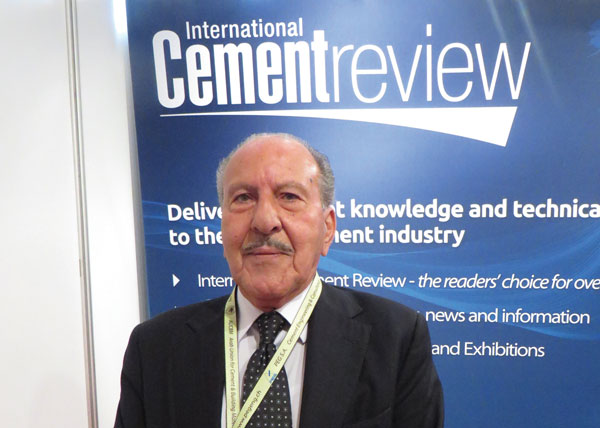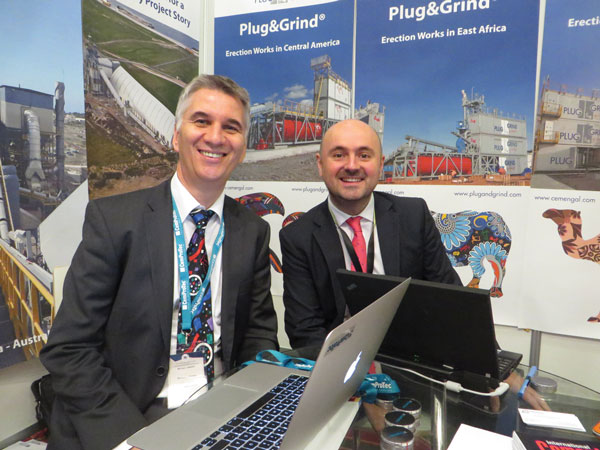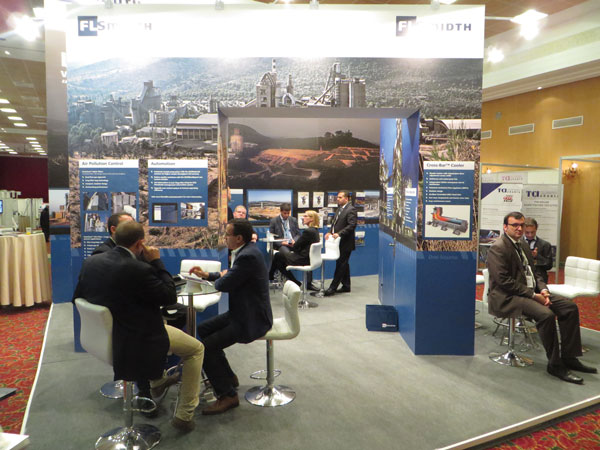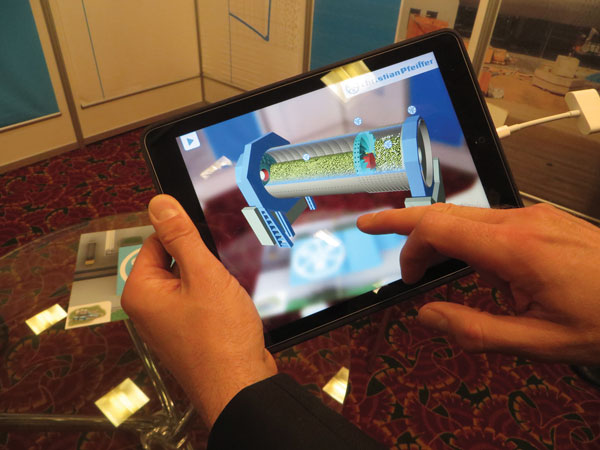AUCBM’s 19th AICCE
The 19th Arab International Cement Conference and Exhibition (AICCE) took place at Le Centre International de Conférences de la Palmeraie in Marrakech, Morocco, on 11-13 November 2014. Held under the patronage of the Moroccan Ministry of Investment, the meeting united over 650 cement producers and equipment suppliers from 39 countries, and included a large 120-stand exhibition, to create the largest industry forum of its kind to serve the Middle East and Africa.

Ahmad Al Rousan, secretary general of the AUCBM, visits the International Cement Review
stand at the 19th AICCE exhibition in Marrakech
In spite of the idyllic setting of palm groves at the Palmeraie Resort, the annual conference and exhibition, organised by the Arab Union for Cement and Building Materials (AUCBM), began with a less than idyllic start, with a large part of the organising team – mostly Syrian nationals – unable to enter the country, due to visa restrictions. It was a reminder of the continued political tensions in the region. Nevertheless, led by the indomitable Ahmad Al Rousan, secretary general of the AUCBM, the meeting proceeded as planned.
Welcome speech
The opening ceremony saw Brahim Laraqui, director general of Asment Temara (Votorantim Group) and host country representative, welcome delegates to the third AUCBM conference to be held in Morocco. A spokesperson for Nabil Elaraby, incumbent secretary general of the Arab League, then provided an overview of the cement industry in the Arab world. The sector comprises 280 companies and cement production of 214Mt in 2012 – insufficient to cover the region's demand, which reached 223Mt in 2013. Noting the great technological strides made by the Arab cement industry, his underlying message was to stress the importance of environmental stewardship and sustainable cement manufacturing, which he argued should remain the absolute priority of the industry going forward.
Exhibition

Michael Janzer, Cemprotec (Germany), and Fernando Duenas,
Cemengal (Spain), talking coolers and grinding systems
With the conference formally underway, delegates filled the great exhibition halls to explore the products and services of 120 technology suppliers representing every conceivable aspect of cement manufacturing technology.
Major turnkey suppliers included FLSmidth (Denmark), CNBM Engineering (China) and ThyssenKrupp Polysius SAS (France), the last of which has recently completed construction of a string of 0.5Mta grinding plants in countries across west Africa for emerging regional player, CIMAF. Fives FCB (France) were also present in the exhibition where Loic Pottier was keen to highlight the company’s role in the capacity development of Algeria, where it is constructing a new 6000tpd line for Entreprise des Ciments et Dérives d’Ech-Chéliff (ECDE) on an EPC basis.
Elsewhere, grinding specialists Christian Pfeiffer (Germany) – responsible for Europe’s largest ball mill circuit at Górazdze Cement (HeidelbergCement) in Poland – gave visitors to its stand an ‘augmented reality’ tour of a grinding plant. Using a new interactive, 3D visualisation, potential customers are able to examine each individual component of a grinding plant in detail via this immersive interface viewed on a tablet or laptop – an innovative tool which uses technology to great effect.

Team FLSmidth (Denmark) at your service: turnkey cement plants from one source
Hawar Power Minerals, a joint venture between the Hawar Group (Qatar) and STEAG (Germany), was also present in the exhibition. The company is in the process of establishing a 10-year fly ash supply agreement with Coastal Gujarat Power Ltd (India). According to logistics manager, Ad Ligthart, Hawar Power Minerals aims to export over 300,000tpa of fly ash, adhering to ASTM618, from the coal power plant to cement and ready-mix producers in Qatar and across the Gulf. The company believes there is a big future for fly ash products to fulfil the region's demand driven by the large infrastructure projects, which require durability in excess of 100 years, and which can best be achieved with fly ash-based materials.
Presentations
Over in the conference hall, a number of excellent presentations highlighted some of the key technologies and new products now available to cement producers. Grinding technologies were covered by the major companies, including Gebr Pfeiffer (Germany) who presented a fascinating overview of the company’s development of vertical roller mills (VRMs) for raw meal and finishing grinding over the last century and a half. Loesche (Germany) was keen to showcase its breakthrough success in installing VRMs for cement grinding for the first time in Saudi Arabia for Southern Province Cement Co.
Extending the life cycle of VRMs was the subject of Dr Franz Muschaweck’s presentation from Dalog Diagnosesysteme GmbH. According to Dr Muschaweck, 60 per cent of gear boxes fail more than once – a figure which can significantly be reduced by employing Dalog’s condition monitoring system. The technology enables the early identification of deteriorating conditions of the bearings and gears to allow timely intervention, and therefore avoid catastrophic failure. For such a critical component in the production line, such an investment would seem prudent!
Michael Suppaner of A TEC (Austria) described how cement producers can use advanced low-NOx calciner technology to increase alternative fuel utilisation up to 100 per cent, while complying with standard emission limits. At the Leube cement plant in Austria such technology, incorporating staged combustion, has successfully reduced NOx emissions by up to 40 per cent.
Markus Kaufmann, Unitherm Cemcon, presented the MAS burner, which is equipped with an adjustable nozzle head for control of flame shape, designed to achieve high substitution rates with alternative fuels while keeping the NOx emission levels well within permitted limits.
Refractories were also well covered by many of the industry’s leading vendors in the conference programme. Dr Sankar Kannabiran, Höganäs Bjuf (Sweden), described the developments of monolithic refractories with added SiC and zircon suitable for ultra-aggressive environments. Later, Eduardo Reis, Magnesita Refractories GmbH (Germany), presented the Total Infiltration per Specific Volume (TISV) methodology for comparing the performance of different brick qualities under various operational conditions, and as a means to improve selection of the correct refractory material for any given kiln.

Michael Halbur, marketing director, Christian Pfeiffer, demonstrates the company’s
new augmented reality tour of a grinding plant
Frank Lichomski of IKN GmbH (Germany) moved the discussion on to the important subject of clinker cooling and described a retrofit of UAE-based Pioneer Cement’s cooler in early 2014, which was installed within the previous cooler’s housing in just 25 days. Michael Janzer, Cemprotec (Germany), explored the history of clinker cooler design, leading to a description of the company’s new ‘smart glider’ design, which has been used to modify an existing pendulum cooler and successfully double aeration capacity, reduce pressure drop and achieve a corresponding fall in temperature from 164°C to 94°C. While typical reciprocating coolers can achieve 65 per cent efficiency, said Mr Janzer, the new smart glider design can reach 95 per cent.
Hicham Ait Chahdad, Caterpillar Power Generation System (UAE), described the latest developments of medium-speed engine power plants. They remain a popular technology in many parts of the MENA region for producers seeking a reliable, independent power supply. These units now have a dual-fuel capability, which includes not only natural gas but also biodiesel, raw vegetable oil and animal fat as a viable alternative to diesel and HFO.
Addressing more specific concerns, Ibrahim Ismail, Cairo University (Egypt), spoke on the energy crisis that has impacted the Egyptian cement industry dramatically over the last few years. The removal of subsidies and fuel allocation issues have resulted in shortages of natural gas, with producers being forced to reduce, and in some cases, halt production. The industry response has been to switch to other fuels as fast as possible and this paper provided an overview of some of the solutions adopted, including RDF, sewage sludge, agricultural wastes and oil shale.
The 19th AICCE was concluded with a fabulous Moroccan banquet and spectacular cultural show at Chez Ali, one of Marrakech’s most famous attractions, to the delight of delegates. ICR now looks forward to participating in the 20th Arab International Cement Conference and Exhibition to be held in Egypt in November 2015. Luxor is the rumoured destination.
Article published in International Cement Review, January 2015.

